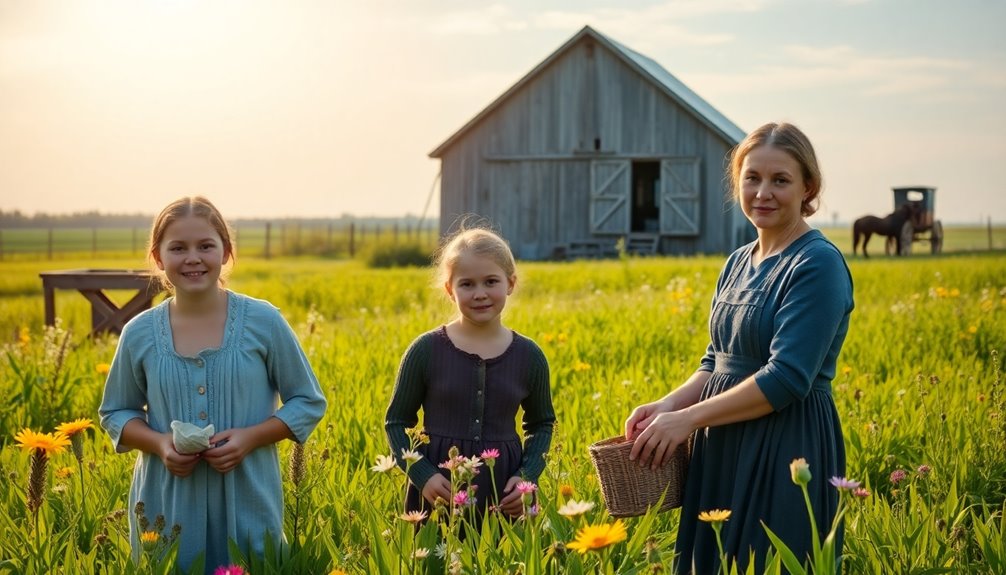The Amish represent a unique blend of religion and lifestyle. Their Anabaptist Christian beliefs guide daily practices, community values, and distinctive traditions. You'll notice their commitment to simplicity, humility, and pacifism in their way of life. Balancing modernity with faith, they adapt while adhering to their unwritten code, Ordnung. The interplay between religious beliefs and lifestyle choices defines their identity. If you keep exploring, you'll uncover even more fascinating aspects of Amish culture and community dynamics.
Key Takeaways
- The Amish are rooted in Anabaptist Christianity, which forms the religious foundation of their identity and beliefs.
- Their lifestyle emphasizes simplicity, plain dress, and adherence to an unwritten code known as Ordnung.
- Adult baptism is a key religious practice, signifying personal faith commitment within the community.
- Community life involves mutual support, cooperative events, and social discipline, reflecting both religious and lifestyle elements.
- The Amish approach modernity and technology with caution, prioritizing their spiritual focus and traditional values over contemporary conveniences.
Understanding Amish Identity
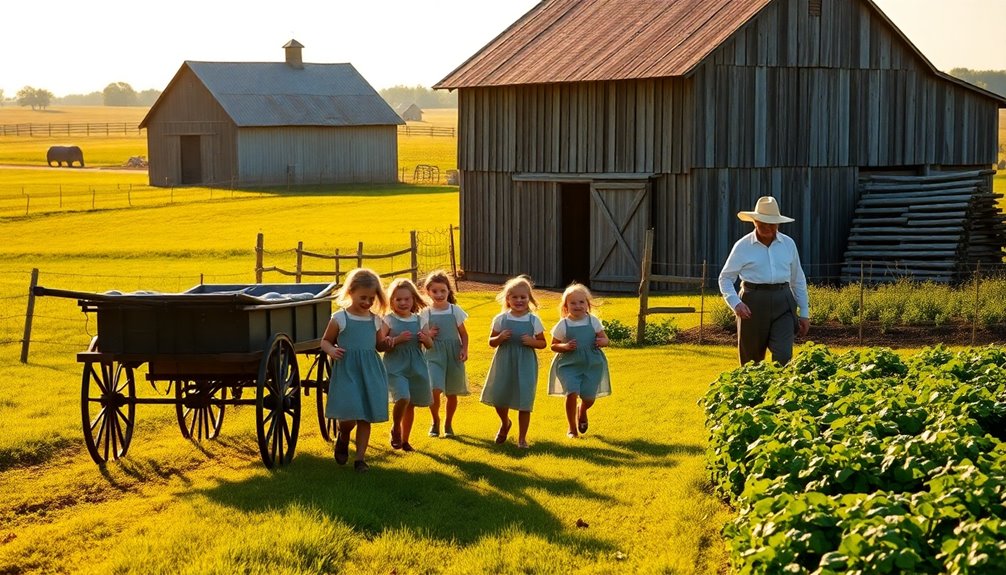
The Amish identity is deeply rooted in their religious beliefs, primarily stemming from Anabaptist Christianity.
You'll find that their Amish faith emphasizes core principles like adult baptism, community, and pacifism. This commitment shapes their Amish lifestyle, which is characterized by simplicity and plain dress, steering clear of modern technology to maintain spiritual focus.
The Amish community is structured around church districts governed by an unwritten code known as the Ordnung, guiding daily living and behavior.
Unlike many religious groups, the Amish don't engage in evangelism; instead, prospective members must fully immerse themselves in their culture and beliefs before baptism.
With over 400,000 members, the Amish uniquely blend religious devotion with cultural practices, creating diverse subgroups within their community.
Historical Roots of the Amish Community
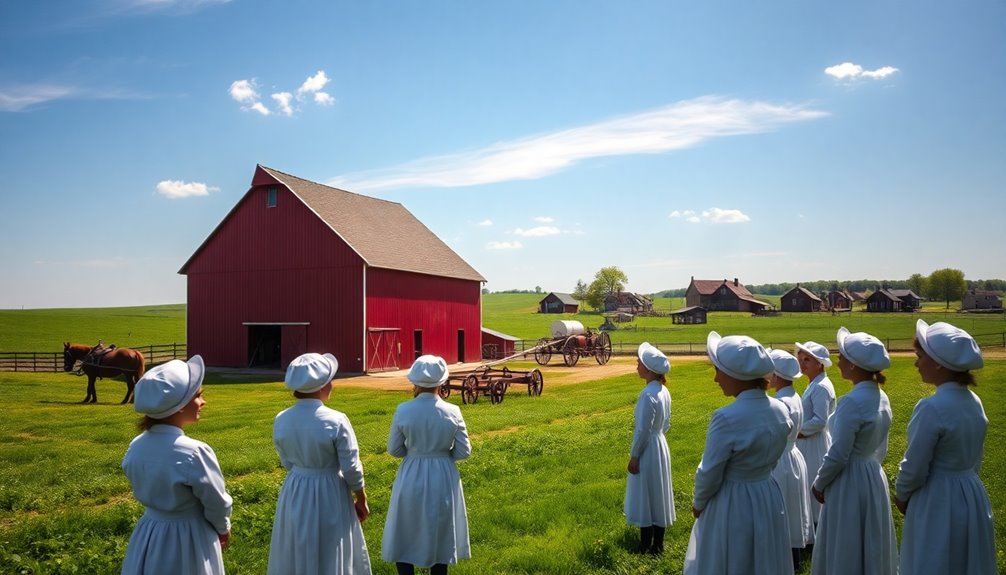
Emerging from the Anabaptist movement in the late 17th century, the Amish community has a rich and complex history. This journey began with Jakob Ammann's schism in 1693, leading to their formation. By the early 18th century, many sought refuge from religious persecution, migrating to North America and establishing settlements in Pennsylvania.
| Year | Event | Significance |
|---|---|---|
| 1693 | Jakob Ammann's schism | Formation of the Amish community |
| 1700s | Early emigration to North America | Search for religious freedom |
| 1850 | Schism between Old Order and New Order | Division of Amish groups |
| 2024 | Population surpasses 400,000 | Growth and cultural impact |
| Present | Majority reside in U.S. states | Continued tradition and lifestyle |
This history shapes the identity of the Old Order Amish today.
Core Beliefs and Values of the Amish
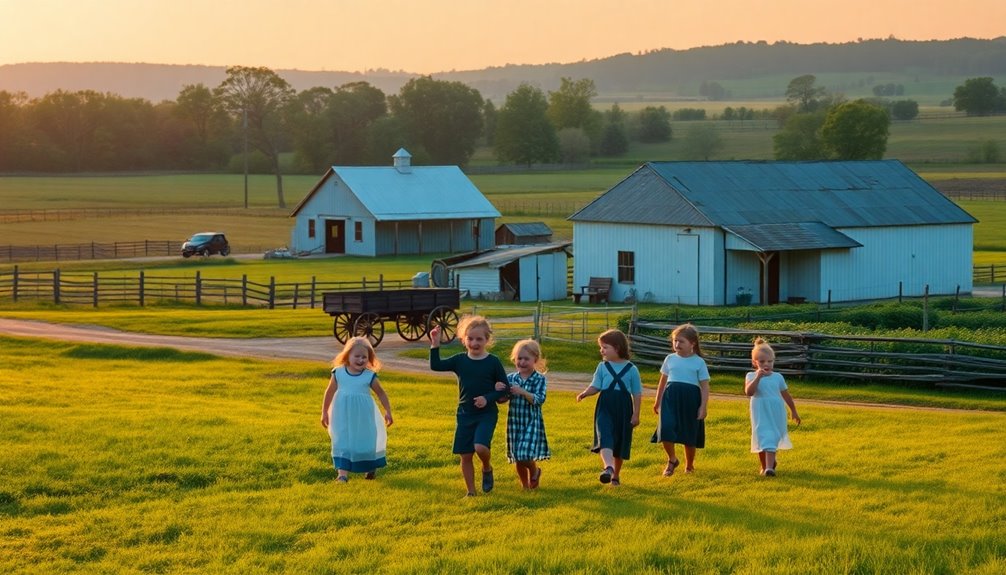
Understanding the historical roots of the Amish community reveals how deeply their core beliefs and values are intertwined with their religious identity.
The Amish adhere to key principles that shape their lives and interactions, emphasizing simplicity and community. Their core beliefs include:
- Humility: Embracing Demut and rejecting Hochmut fosters a spirit of submission to God's will.
- Pacifism: Valuing peace influences their approach to conflict and relationships.
- Adult Baptism: This practice underscores the importance of personal faith commitment.
In Amish life, the Ordnung guides daily behaviors, reflecting their commitment to a lifestyle distinct from modern society.
Mutual aid strengthens community and family bonds, ensuring that members support one another, particularly in times of need.
The Role of Community in Amish Life
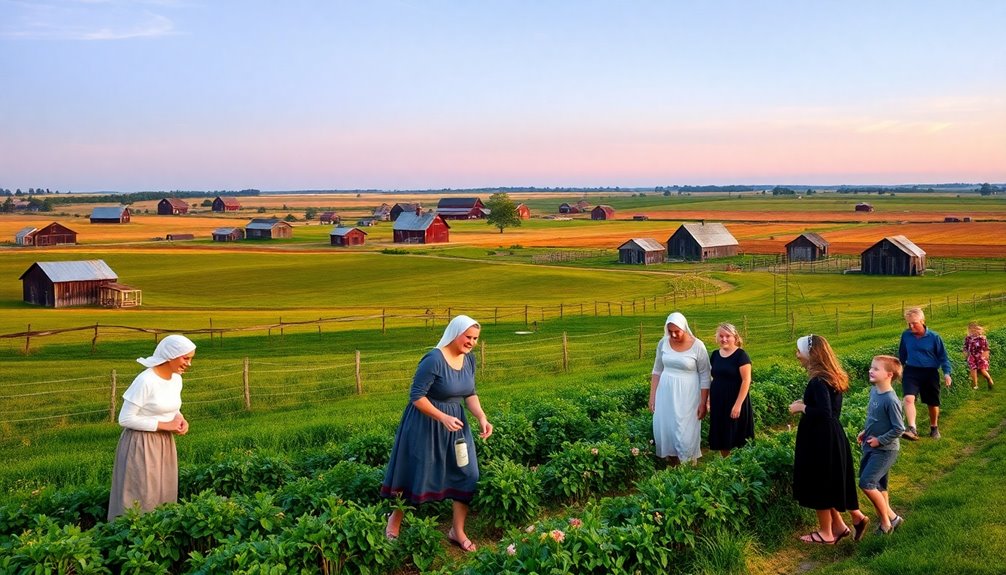
In a world often dominated by individualism, the Amish community stands out for its strong emphasis on collective identity and mutual support.
Structured into church districts of about 75 baptized members, Amish families cultivate close-knit relationships that enhance their social fabric. Events like barn raisings and quilting bees highlight their cooperative spirit, fostering connection and shared values.
When it comes to healthcare and financial needs, they rely on community support, often funding treatments through benefit auctions instead of commercial insurance.
Social control is maintained through practices like shunning, ensuring adherence to community norms.
With large families, typically seven to ten children, the strength and growth of the community remain paramount, reinforcing the bond among church members and families alike.
Distinctive Practices and Traditions
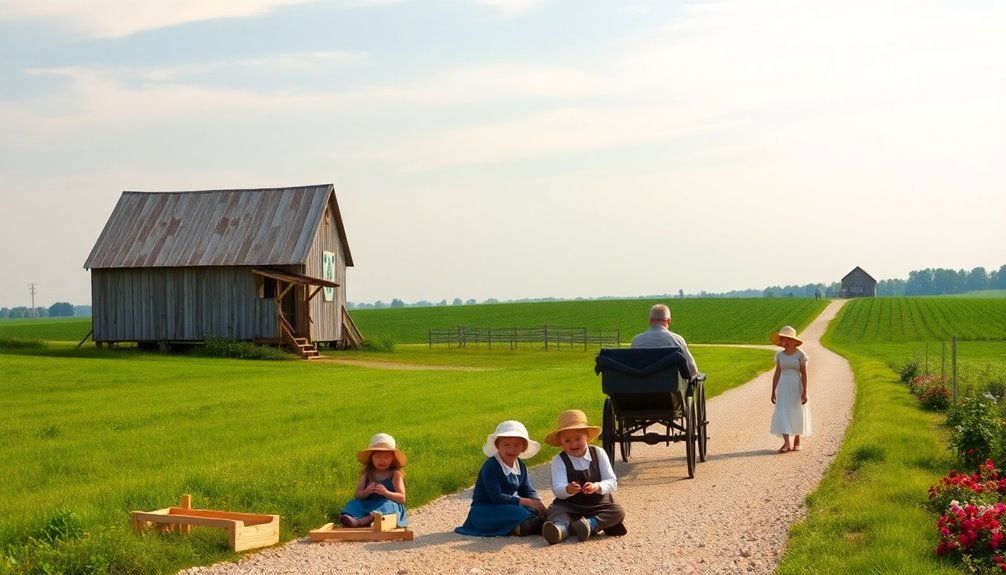
Five core practices define the distinctive lifestyle of the Amish, showcasing their commitment to simplicity and community values.
These traditional Amish practices reflect their unique culture and social structure:
- Ordnung: An unwritten code that governs behavior, dress, and technology use.
- Traditional Clothing: Men wear broad-brimmed hats and dark suits, while women don bonnets and long dresses, symbolizing humility.
- Community Engagement: Activities like barn raisings and quilting bees reinforce social bonds and collective support.
Education for Amish children typically ends after eighth grade, focusing on practical skills and Amish history.
In addition, the practice of shunning (Meidung) helps maintain social order, ensuring members adhere to community standards.
These distinctive practices not only define Amish culture but also strengthen their communal identity.
The Impact of Technology on Amish Lifestyles

While many modern communities embrace technology in daily life, the Amish approach it with caution and discernment.
You'll notice that Amish living often rejects modern conveniences like television and home computers, yet some communities do permit limited use of solar power and 12-volt electricity for essential farm equipment.
Horse-drawn buggies remain a staple, reflecting their choice to avoid car ownership and maintain a separation from the modern world.
Curiously, while posing for photographs is generally forbidden, some families allow long-distance shots, showcasing a selective acceptance of technology.
The Amish also prioritize community support over commercial health insurance, demonstrating their commitment to self-sufficiency.
Ultimately, different Amish subgroups exhibit varying degrees of technology acceptance, highlighting the diversity within their lifestyles.
Education and Child Rearing in Amish Culture
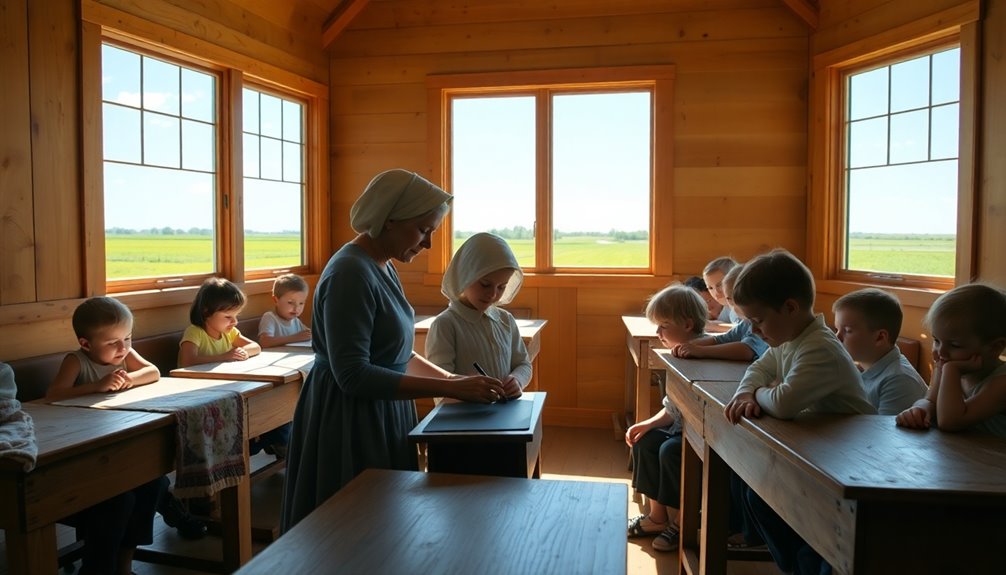
Education and child-rearing in Amish culture are deeply intertwined with their values and way of life. Children typically attend one-room schools, learning up to the eighth grade with a focus on practical skills and community values. The U.S. Supreme Court's decision in 1972 allowed them to prioritize their unique teachings over formal education.
Key aspects of Amish education and child-rearing include:
- Emphasis on strong family ties and a robust work ethic.
- Involvement in household chores and community activities from a young age.
- The tradition of Rumspringa, allowing youth to explore life outside their community before committing to church values.
This approach fosters a close-knit community and supports the Amish way of life.
Religious Observances and Church Structure
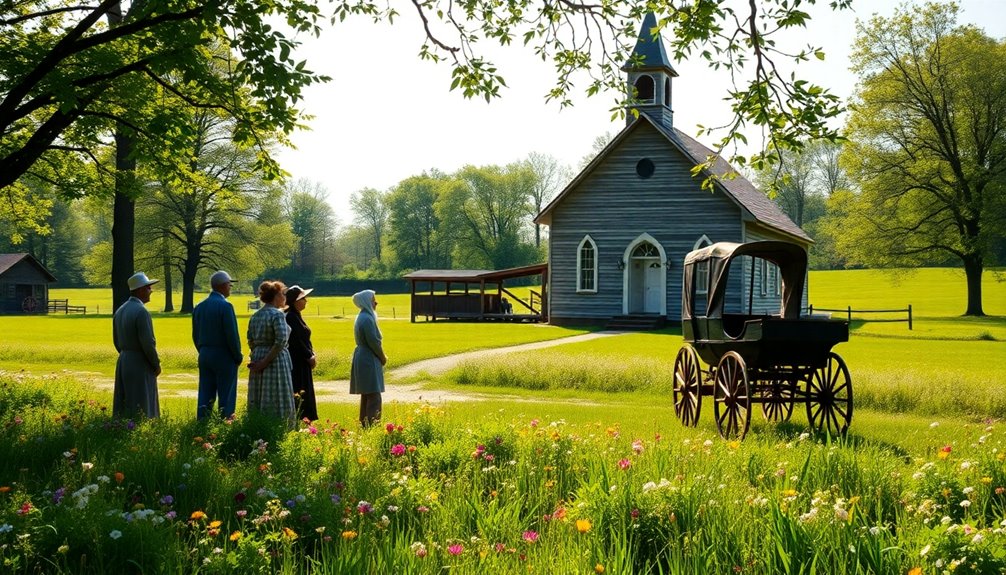
The values instilled during childhood carry over into the Amish community's religious life, shaping their observances and church structure.
Rooted in their religious beliefs, the Old Order Amish Mennonite Church emphasizes adult baptism and adherence to the Ordnung, guiding daily life.
Church services occur biweekly in homes or barns, often drawing up to 150 church members who need bench wagons for seating.
Each church district comprises 20 to 40 families, with leaders like ministers, deacons, and bishops chosen by lot from the congregation.
Baptism marks a lifelong commitment, and breaking this commitment can lead to excommunication.
Central to their worship, the Ausbund hymnal, in use since 1564, features hymns sung in unison, reflecting the deep faith of Amish communities.
Shunning and Community Discipline
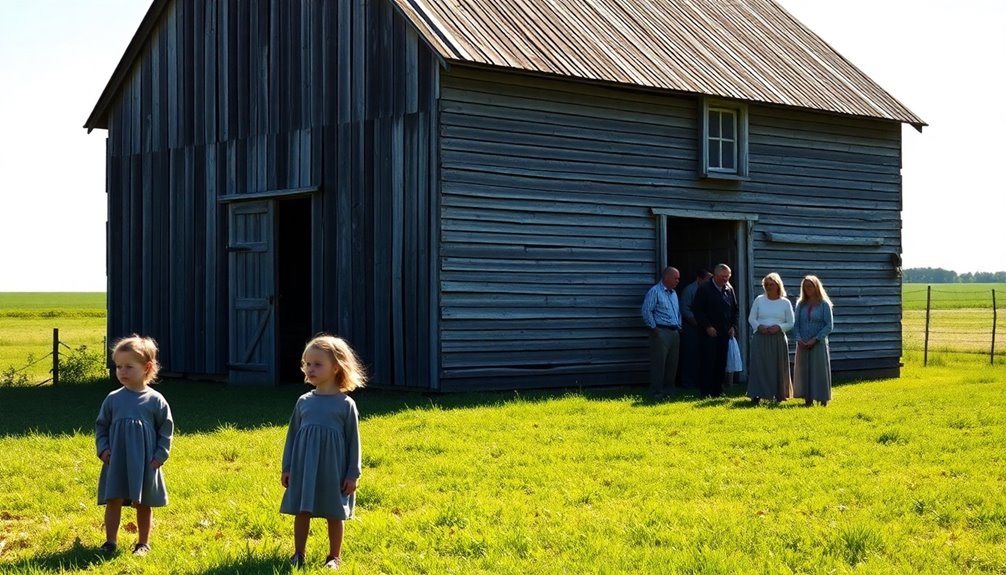
Shunning, or Meidung, plays an essential role in maintaining discipline within the Amish community, addressing disobedience and violations of their strict communal rules. This practice varies in strictness among different Amish subgroups, but it serves to uphold the Ordnung, their unwritten code of conduct.
When discussing shunning, consider these key aspects:
- Shunned individuals may live apart from their families but can still attend significant events, revealing the tension between rules and family bonds.
- Reinstatement requires confession and a demonstration of repentance, emphasizing the community's commitment to discipline.
- Unbaptized members who leave the faith aren't shunned, highlighting a distinction in community discipline based on baptism status.
Through shunning, the Amish endeavor to maintain social control and church purity.
Navigating Modernity: The Amish Perspective

While many view modernity as a path to progress, the Amish approach it with careful consideration, balancing their commitment to tradition with the realities of contemporary life.
Amish believe that a simple life of faith is essential, often rejecting modern technology that could disrupt their close-knit community. Each community follows the Ordnung, guiding decisions on acceptable technologies.
While some, like the New Order Amish, may embrace certain conveniences, the Old Order Amish typically avoid anything that threatens their spiritual focus. They engage with modernity selectively, allowing solar power or battery-operated devices when these align with their values.
Despite their separation, the Amish adapt to economic changes without compromising their core beliefs, shifting from agriculture to small businesses while maintaining their traditions.
Frequently Asked Questions
Is Being Amish a Lifestyle?
Yes, being Amish is definitely a lifestyle. You engage in practices that prioritize simplicity, humility, and strong community ties.
Your daily life revolves around the unwritten Ordnung, guiding your choices in areas like clothing and technology. You often embrace manual labor and agricultural work, shunning modern conveniences to maintain your unique way of living.
Family is central, too, with large families and multi-generational homes fostering a close-knit community atmosphere.
Is Amish Considered a Religion?
Yes, Amish is considered a religion.
You'll find that the Amish adhere to Christian beliefs, rooted in the Anabaptist tradition. They practice adult baptism, emphasizing a personal commitment to their faith.
Their worship services, held biweekly, reflect a strong sense of community and shared values.
Do Amish Marry Their Cousins?
Imagine a small, close-knit village where love often blooms among familiar faces.
Yes, the Amish do marry their cousins, a practice woven into their cultural fabric. By marrying within their community, they strengthen family ties and preserve their unique identity.
While cousin marriages are common, the Amish also seek partners from outside their immediate circle to diversify their genetic lines, carefully balancing tradition with health considerations.
It's a thoughtful approach to community bonding.
Do Amish Sleep in Separate Beds?
No, Amish couples typically don't sleep in separate beds after marriage. Instead, they share a bed, which symbolizes their commitment to each other and their family values.
This practice reflects their emphasis on unity and community. While you might find slight variations among different Amish subgroups, the general norm is to foster closeness through shared sleeping arrangements, while still respecting the couple's need for personal space within their partnership.
Conclusion
To sum up, the Amish identity beautifully intertwines religion and lifestyle, creating a unique way of life rooted in community and faith. Some might argue that their practices are too restrictive, but these boundaries actually foster deep connections and a sense of belonging. By choosing simplicity and communal values, the Amish provide a compelling example of how a cohesive lifestyle can enhance spiritual fulfillment. Ultimately, their way of living challenges us to reconsider our own definitions of faith and community.
